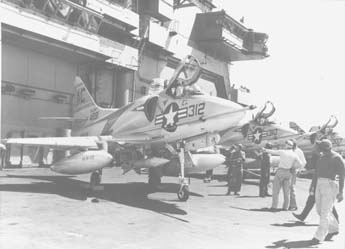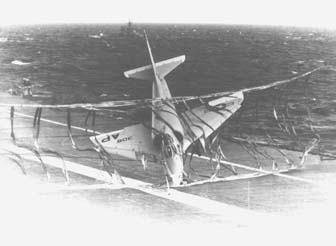|
LONG SERVING SKYHAWK FADES FROM AMERICAN SERVICE, STILL SOLDIERS ON ELSEWHERE
This terrific piece of aviation history was first published in the Atlantic Flyer, and we reprint it with permission.
If you, like author Ken Kula and me, are old enough to have seen the Blue Angels fly the Skyhawk, you remember what a treat that was.
My first acquaintance with the A-4 came on a visit to the Naval Academy, which was near my home. I believe they still have the same aircraft on static outdoor display, though my recollection is that the last time I saw it, it wasn’t in good condition.
The Blues transitioned to the “Hawk” from the venerable but fuel-hogging McDonnell-Douglas F-4 Phantom II. The A-4 was not only much more fuel-efficient, but vastly more maneuverable --its roll-rate is an astonishing 720 degrees per second. Not to mention that it´s just plain prettier.
If you´d like me to date myself further, I´ll admit to seeing the Blues when they were flying the fabulous F-11 Tiger, which was, at the time, the latest cat out of the Grumman lair. --C.W. Austin
LONG SERVING SKYHAWK FADES FROM AMERICAN SERVICE, STILL SOLDIERS ON ELSEWHERE
by Ken Kula

The Blue Angels chose the A-4F for flight demonstrations in 1974. - photo by Ken Kula
The U.S. Navy retired its last Douglas TA-4J Skyhawk jets from squadron service in September 1999. The retirement ended a span of 45 years during which the Douglas A-4 Skvhawk had performed continuous service for the United States. Originally envisioned as a carrier-based, lightweight nuclear bomber, the prototype YA-4D-l first flew in 1954. Two thousand nine hundred and sixty airframes later, production ended in 1979. The Skyhawk had the longest production run of any tactical bomber in U.S. history.
Along the way, the A-4 picked up names such as: the Bantam Bomber, Tinker Toy, Scooter, and Heinemann's Hot Rod. Extensively used as an attack bomber during the Vietnam War, versions also served as advanced jet trainers for both the US Navy and Marine Corps. Various models of the Skyhawk have been operated by nine countries. Some nations still have this versatile aircraft in first-line use today. The jet was a mainstay for Israel during two different wars. In recent history, Kuwait Skyhawks flew missions against their Iraqi aggressors, and Argentinean Skyhawks nearly turned back the British task force during the battle for the Falkland Islands. Here's how the Skyhawk evolved and some of its accomplishments:
Early Design and Development
Douglas Aircraft Corporation's Edward Heinemann designed the A-4 Skyhawk in answer to a U.S. Navy requirement for a fast, compact, lightweight attack jet, capable of delivering a nuclear weapon. Improvements in top speed, range, and bomb load were required over the capabilities of earlier attack jets such as the Panther and Banshee. The resulting design was a single-seat. semi delta-winged jet. The design's wing span was smaller than that of a Piper Cub, allowing for superb handling aboard an aircraft carrier. Constructed around a Wright J65 engine with 7200 pounds of thrust, the YA4D-1 prototype first flew on May 22, 1954, with Douglas' Bob Rahn at the controls. The "Y" stood for prototype, "A" for Attack, "4D" for Douglas' fourth attack design, and the "-I" stood for the first variant of the A-4D. Back to top.

Early carrier-borne A-4B Skyhawk armed with a Bullpup air-to-ground missile circa 1959.
- photo USN/NMNAS
The prototype aircraft met and surpassed the Navy's requirements. Orders were immediately issued for an initial production run. Nicknames of "Heinemann's Hot Rod" and "Scooter" spoke of its size and speed. An example of the initial production version, the A-4A, set a world speed record over a 500-kilometer course flying at 695 miles per hour on October 15, 1955. The jet could carry up to 10,000 pounds of ordnance, and was armed with twin 20mm cannons in the wing roots.
The first Navy attack squadron equipped with the newest tactical attack jet in the U.S.'s inventory was VA-72, the Blue Hawks. The Marine Corps took delivery of their first A-4A via VMA-224, the Bengals, soon thereafter. Both of these deliveries occurred in late 1956. Soon, another version, called the A-4B, was introduced that incorporated the capability of buddy refueling between aircraft. Some single-seat A-4As and A-4Bs were modified to become training aircraft, mainly for VFR conditions.
In 1958, an all-weather version, the A-4C was introduced. The fuselage was stretched some six inches longer, making more room available for increased avionics. The A-4C was the standard Navy attack jet in most light attack squadrons through the early 1960s. By the summer of 1961, the newest version of the Skyhawk, the A-4E, was introduced. This variant was a foot longer than the then standard A-4C, mainly due to its new Pratt & Whitney J52 engine. The engine delivered 2,000 more pounds of thrust, adding a greater margin of safety to the Skyhawk's carrier operations, as well as delivering a slightly higher top speed for the aircraft,
War Years for the Skyhawk
The Skyhawk received its baptism by fire in military service at the beginning of the Vietnam War in 1964. Both the U.S. Navy (from aboard aircraft carriers) and the U.S. Marines (operating from both carriers and airfields in South Vietnam) used the A-4C and A-4E extensively for attack missions ranging into North Vietnam. The A-4's air-to-air refueling capability enabled it to carry full loads of ordnance into the air, and to add to its fuel load in-flight via the hose and drogue (probe and basket) method. Air refueling was a common occurrence from other A-4s. KA-6 Intruders, and KA-3 Skywarriors while traveling both to and from the 'hot zone."

Final attack version of the Skyhawk was the Marines A-4M version, such as this
South Weymouth based example. - photo by Ken Kula
Several well-known veterans were victims of anti-aircraft fire while flying Skyhawks. Medal of Honor recipient Vice Admiral lames Stockdale (Ret.) was shot down while making a low-level bombing pass in a rail yard in North Vietnam. U.S. Senator John McCain was another unfortunate A-4 pilot that was shot down during the war. A total of 195 A-4s were shot down by North Vietnamese flak and MiGs
The weapons that the A-4 used in Vietnam ranged from unguided "dumb" bombs to the newest "Bullpup" rockets, "Walleye" TV bombs, and Shrike anti-radiation missiles. Navy Skyhawks flew night interdiction raids using flares dropped from one of a team of two jets working in tandem. Some versions of the Skyhawk could carry AIM-9 Sidewinder air-to-air missiles, and they were all equipped with twin 20mm cannons available for dogfighting. Although during tie war no enemy aircraft were downed by Sidewinders or cannon fire, one Skyhawk pilot did actually down a MiG-17 with a pod full of 2.75 inch unguided rockets! Back to top.
New versions of the Skyhawk were developed to deal with operational shortcomings of the earlier models. The A-4F was equipped with an 11,200 pound thrust Pratt & Whitney J52 engine, producing more thrust to overcome the hot temperatures found iii the Vietnam theatre. Some aircraft were fitted with a hump along the top of its fuselage, providing extra space for avionics. The year 1966 saw the introduction of two important twin-seat trainer versions, the TA-4F and TA-4F. The TA-4 family is a two-seat jet trainer version whose trainee is located in front seat, with the instructor in the rear. Soon the Marines replaced their A-I Skyraider prop-driven aircraft with TA-4Fs as forward air control platforms in combat, with an observer taking the place of the trainee in the front seat. Of note: the A-4F version served as the mount of the U.S. Navy's Blue Angels from 1974 through 1986. Back to top.
Final Versions, Including the Super Skyhawk
Constant improvements to the Skyhawk brought three final versions into operational use. In 1969, the Navy's first twin-seat TA-4J advanced trainer was introduced. The TA-4J was more powerful and improved upon the TA-4F's performance.
This version became the US Navy's advanced jet trainer, capable of landing on aircraft carriers and land, as well as training students in weapons delivery.

Ouch! A4D-2 Skyhawk, takes the barrier aboard the USS Essex on February 5, 1958.
- photo William, E. Scarborough via NMNA
In April 1970, the first A-4M Skyhawk II, otherwise known as the Super Skyhawk. was delivered to the Marine Corps. The Super Skyhawk contained upgraded avionics and the most powerful engine used in any variant. A hump along the aircraft's spine offered additional room for avionics. The Hughes Angle Rate Bomb Sight system was incorporated into the nose of the jet. and various humps and bumps grew on active Skyhawks, as their electronics were continually upgraded. Ultimately, the A-4Ms were relegated to Marine Corps Reserve squadrons, except for a handful that served as aggressors with the Naval Fighter Weapons School. The U.S. Marines also ordered a twin seat version of the Super Skyhawk, called the OA-4M. for forward observation duties. The last of the Super Skyhawks were phased out of service by 1995, replaced by F/A-18 Hornets and AV-8B Harriers.
The TA-41 trainers proved harder to phase out of U.S. service. The need for a high performance jet trainer for aircraft carrier duties allowed the twin-seat variants to soldier on right up to the end of the century. The replacement for the TA-4J still cannot fill the Skyhawk's shoes; the T-45 Goshhawk is not powerful enough during a certain critical part of a "bolter," thus it cannot be used for advanced training aboard carriers. Student pilots now transition to their primary type of aircraft in fleet use before attempting to land aboard a carrier, or use a T-2C Buckeye, a primary jet trainer still in use for carrier landings. Back to top.
Foreign Interest
McDonnell Douglas successfully exported various versions of the Skyhawk around the world. In 1965, Argentina became the first overseas customer for the Skyhawk, ordering 75 refurbished Navy A-4B and C's, and later, 16 A-4Q versions. Australia purchased a total of 30 single and twin-seat Skyhawks, ultimately selling the surviving aircraft to New Zealand after 1982. Indonesia, Malaysia, Singapore, and Kuwait are or have been other Skyhawk operators.
Israel has been the most prolific Skyhawk owner and operator worldwide. Almost 300 aircraft have been flown by the Israeli Air Force, bought between 1967 and 1973. Israeli Skyhawks became operational in 1968, and performed attack duties during the so-called War of Attrition through 1970. The jets also played an important role during the Yom Kippur War in 1973. Today, although retired from front line service, both single and twin-Seat Skyhawks serve as trainers in the Israeli Air Force.
During the Argentinean/British war over the Falkland Islands, Skyhawk performance was surprisingly effective. Although limited to a few precious minutes in the combat zone due to long range flying from their land bases, Argentinean Skyhawk pilots helped sink four ships and damage almost a dozen others. The sunken ship total would have been higher if not for bombs that did not explode due to incorrect fusing for the type of close-in attacks being made. Nineteen Argentinean Skyhawks were lost during battle, and many of these have since been replaced with later model A-4M and OA-4M aircraft retired from the US Marine Corps.
The newest customer for the Skyhawk is Brazil. In 1997, the country purchased all of the remaining Kuwaiti A-4s, and formed a squadron to operate from their aircraft carrier, Minas Gerias. The Kuwaiti Skyhawks were some of the last built in 1977, with low airframe times and in good overall condition, having been flown in a dry desert climate for most of their lives.
Although the Skyhawk has been retired by the US Navy and the Marines after a long and illustrious career, this tried and true aircraft will continue to operate well into the 2lst century as front line bombers and trainers around the globe.Back to top.
|